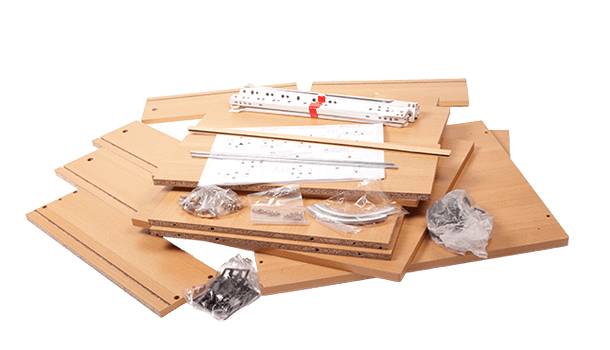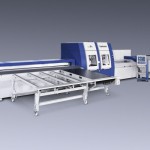Theory of Constraints is a concept that requires the improvement actions focus on the bottleneck that determine the overall capacity of the company.
It is based on the 3 following :
![]() The imbalance between load and capacity has become inevitable, there is always a bottleneck somewhere in the system.
The imbalance between load and capacity has become inevitable, there is always a bottleneck somewhere in the system.
![]() One hour lost on the bottleneck is one hour lost on the plant so one hour of Turnover lost.
One hour lost on the bottleneck is one hour lost on the plant so one hour of Turnover lost.
![]() An hour saved on a non-bottleneck is an illusion.
An hour saved on a non-bottleneck is an illusion.
Here are 3 examples of the application of TOC in the wood and furniture industries:
- Kitchen manufacturer by order
- Timber joinery manufacturer by order
- Furniture manufacturer
Kitchen manufacturer by order
 This is the case of a company selling and producing kitchens by order. The need is 120 to 150 furnitures per day. The service rate of the company is low due to incomplete orders and delivery delays.
This is the case of a company selling and producing kitchens by order. The need is 120 to 150 furnitures per day. The service rate of the company is low due to incomplete orders and delivery delays.
The implementation of the Theory of Constraints took place according to the 5 steps.
After a diagnosis on the set of resources, it has been found that the bottleneck is the clamp. A technology time of 3 minutes is required for each cycle. The company working on 8 hours, the daily maximum volume is 160 units. All other resources (speed, machining, materials supply, ..) have a higher capacity.
It turned out that the clamp could not reach this theoretical rate. Various actions have been implemented :
- Put online the clamp to avoid handling upstream and downstream and therefore generate stops and scrap.
- Having a signaling system to control the sequence of cycles and avoid unplanned downtime.
- Implementation of preventive maintenance on the machine (TPM)
- Establishment of procedures on the workstation.
![]() Subordinate evetything to the constraint
Subordinate evetything to the constraint
A set of LEAN projects were deployed :
- Creating a continuous assembly line starting from the preparation of components and up to packing and shipping Local.
- Distribution of different posts along this line with balancing based on the Takt Time.
- Implementation of supermarkets along the line.
- Preparation of components in trolleys per order and quality control right out of the machining. Mounting a command is launched when a trolley is complete and compliant.
- Launching optimizing cut in relation with orders and that with a delay of 4 days if necessary with anticipation of the following components in order to optimize the material.
- Commercial schedule deliveries based on minimum manufacturing time and weekly capacity of clamp.
Various issues were discussed :
- Technological improvement: type pins, glued
- Optimization framing putting more furniture in a cycle optimized width 1.80m
- Setting up an additional team
![]() Back to step 1 : Continuous improvement
Back to step 1 : Continuous improvement
Once the increased capacity, the bottleneck will move. Following the diagnosis, it turned out that the next bottleneck will be the Nesting workstation. It will then apply the five steps on this new constraint.
Timber joinery manufacturer by order
It is a company that markets and produces wooden windows by order. The need is 20 windows per day. These windows are finished and painted in factory. The service rate is low due to the incomplete orders and delivery delays.
The process is as follows :
- Cutting
- Currying
- Machining
- Clamping
- Painting
- Laying glazing
- Schoening
- Packaging
The implementation of the Theory of Constraints took place according to the 5 steps.
After a diagnosis on the set of resources, it has been found that the bottleneck is the machining center which processes the windows order by order. The center is able to achieve up to 20 windows in 10 hours. All other resources are over-capabilities.
It turned out that this machine is far from reaching its rated speed. Various actions have been implemented :
- Put in place a signal upon discontinuation of machining center (dust on cell, through wood, …).
- Ensure smooth loading of the machine.
- Implementation of preventive maintenance on the machine (TPM)
- Development workstation and manual clamping workstation.
![]() Subordinate everything to the constraint
Subordinate everything to the constraint
A set of LEAN projects were deployed :
- New layout of the plant.
- Deleting tables rollers on which the components were stored and replacement by picking trolleys by order.
- Order picking by trolleys right out of cuting.
- Commercial schedule depending on the capacity of this machine.
- Quality control in output cutting and output currying.
- Standardization of raw materials.
- Preparation and control engineering and design machining files.
The points raised :
- Increased opening rate of the machine (cross-team).
- Realization out of the machine of some machining (some drilling).
- Optimization of machining programs.
![]() Back to step 1 : Continuous improvement
Back to step 1 : Continuous improvement
At the end of the mission, the capacity of this machine was still the lowest. But the diagnosis has shown that when the majority of the windows will be delivered with integrated finishing, the bottleneck will move to the painting line. It will then apply the five steps on this new constraint.
Furniture manufacturer

We are in the case of a company with a number of employees and major equipment manufacturer and selling various kinds of furniture. These furniture are either made to order or made on forecasts.
The organization of company is based on a set of units located on the same site. The same equipment can be found in several units. The same products can be made in different units.
![]() The company has a low productivity problem.
The company has a low productivity problem.
I will not detail you 5 step process, but you detail the various constraints identified.
Here, constraints are not resource constraints, but constraints of belief and company policy.
Identical machines presence in various workshops
The same machines are found in 3 or 4 workshops. Therefore, the volumes applied for each machine are relatively low. The setup are important. In addition, due to the proliferation of these machines, the maintenance operations are multiplied. Streamlining processes workshops will remove some equipment, keeping only the best performers.
At the level of society, officials believe that this duplication is a guarantee of security.
Realization of identical products in different workshops
Rationalization leads to better productivity and avoids many handlings.
But here too we find the same belief of ‘security’
Invoicing between workstation
The company systemized billing between workstations (eg between cutting and machining, between machining and drilling). It follows a major constraint in : people who perform data entry in workshops and staff that integrates this data into ERP. This bottleneck can be easily eradicated : removal of these invoices, for the question to ask is: what’s in it for the customer?
General productivity
Productivity on workstations is very low. The facilities are open seven hours a day with a break from 1:30 at noon and 4:30 on Saturday morning. Knowing that productivity losses are the most important to starting and stopping of production, it would be wise to increase the daily hours (removing the Saturday morning), and even closer to the day continues. The company is also looking to save on energy costs, the new organization would go in the right direction.
Here the belief is that by working on Saturday morning, the service rate improved. But if there are delays, deficiencies, we must rather seek the root cause.
Conclusions
The Theory of Constraints is applicable in industries of wood and furniture.
- There is always a bottleneck.
- Compared to the bottleneck, apply the DBR principle: Drum – Buffer – Rope. The bottleneck gives the rate, a buffer stock (production time) is created to fully use the bottleneck, and finally, the scheduling is managed in relation to the bottleneck.
- The exploitation of the neck is enhanced by LEAN projects.
- The constraints are of several types : Resources, beliefs, standards, company policies.
And following these three examples, it is clear that it is much easier to improve and even eliminate resource constraints as constraints belief or company policy constraints.
“We have always done like that” – “We can not change our habits”
The challenged are very difficult !!!




One Reply to “Theory of Constraints in the wood and furniture industries”
Comments are closed.